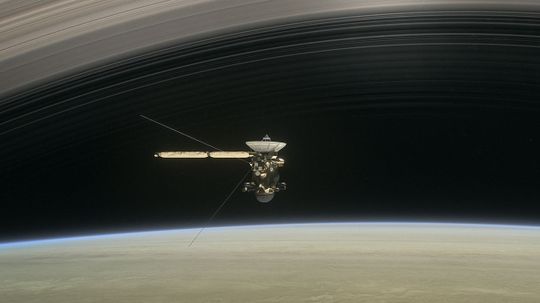Hold on tight, folks! We’re about to dive into the thrilling tale of why Cassini crashed. Brace yourselves for a wild ride!
The Risky Mission Begins
Picture this: a brave spacecraft named Cassini hurtling through space with one mission in mind – protecting the icy moon Enceladus. This ain’t your average joyride; it’s an interstellar adventure like no other.
Cassini was armed with cutting-edge technology and a team of brilliant minds from NASA and the European Space Agency. Their goal? To unlock the secrets hidden beneath the frozen surface of Enceladus, a moon that could hold clues to extraterrestrial life.
But here’s where things get dicey – in order to protect Enceladus, Cassini had to make some tough choices along its journey.
A Deadly Dance with Saturn
Saturn, that magnificent ringed planet we all know and love, became both friend and foe to our intrepid explorer. As Cassini ventured closer to Saturn’s gravitational pull, it risked being sucked into oblivion or crashing onto one of its many moons.
But hey, sacrifices must be made for science! So Cassini took on this deadly dance with Saturn, weaving through its rings like a skilled Geordie dancer at a local pub on Saturday night. It dodged debris left and right while capturing breathtaking images of Saturn’s majestic beauty.
The Final Plunge
All good things must come to an end, they say. And so did Cassini’s epic journey as it prepared for its grand finale – plunging straight into Saturn itself.
Why, you ask? Well, it’s all about protecting Enceladus. Scientists feared that if Cassini ran out of fuel and drifted aimlessly through space, it could potentially crash into Enceladus and contaminate its pristine environment.
So instead of risking such a catastrophe, the decision was made to send Cassini on a one-way trip into Saturn’s atmosphere. It burned up like a firework on Bonfire Night, sacrificing itself for the greater good.
The Legacy Lives On
Cassini may be gone, but its legacy lives on in the wealth of knowledge it provided us about Saturn and its moons. The data collected during its daring mission continues to be analyzed by scientists around the world.
We now know more than ever about Enceladus – from its subsurface ocean to potential hydrothermal vents that could harbor life. Thanks to Cassini’s sacrifice, we’re one step closer to unraveling the mysteries of our universe.
In Conclusion
Cassini crashed and burned so that icy moon Enceladus could remain untouched by human interference. Its journey was filled with risks and sacrifices but ultimately paved the way for groundbreaking discoveries in space exploration.
So let’s raise a pint (or two) to Cassini – an Arctic adventurer with a Geordie spirit who showed us just how far we’re willing to go in our quest for knowledge!



